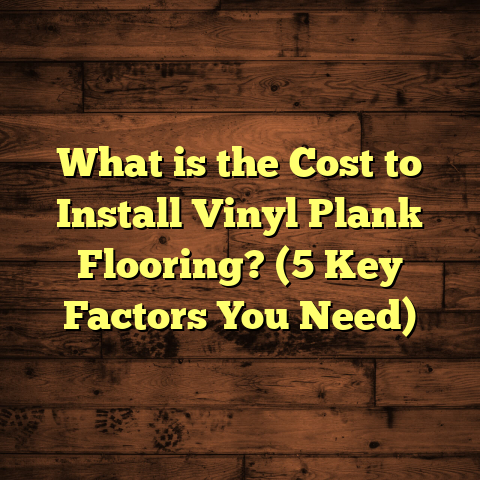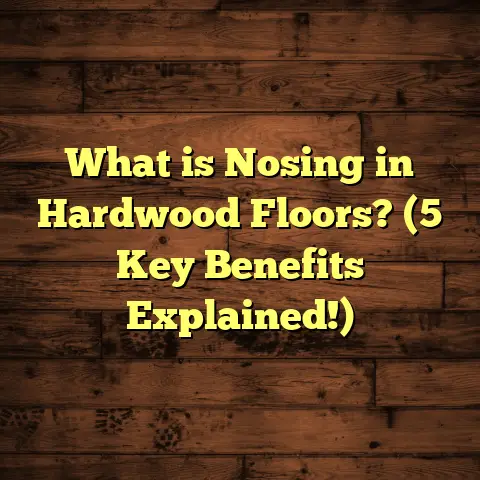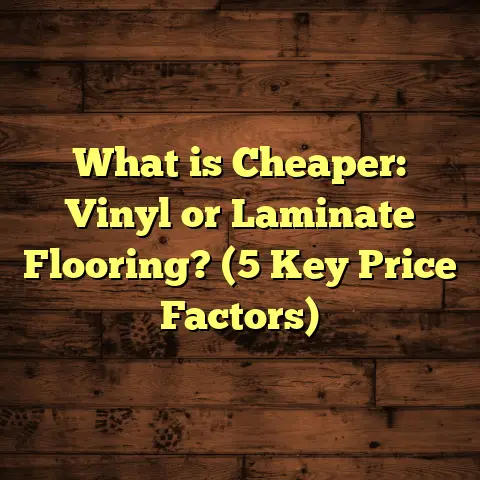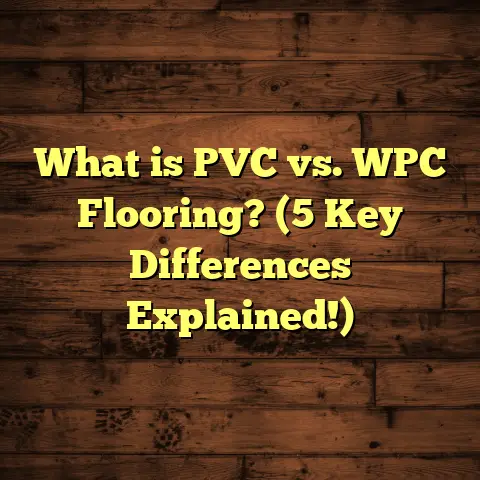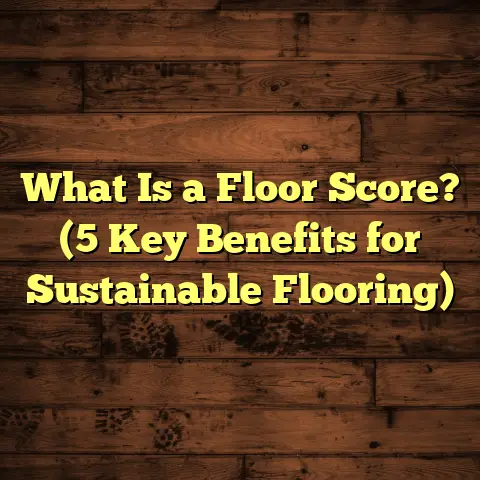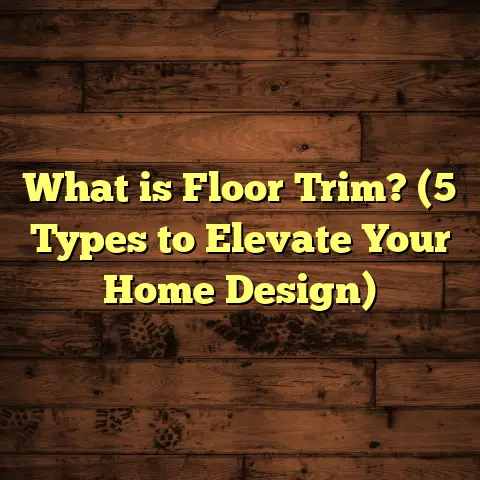What is Click LVT Flooring? (5 Benefits You Must Know!)
What if you could change your floors without the hassle of dust, heavy tools, or expensive professional installation? Imagine snapping together planks that look like real wood or stone but resist scratches, moisture, and wear far better than traditional materials. What if your new floor could be installed in a weekend, feel comfortable underfoot, and last for decades with minimal upkeep? That’s what click LVT flooring has brought to my projects time and again, and it might just be the perfect fit for your home or business.
What is Click LVT Flooring?
Click LVT stands for Click Luxury Vinyl Tile flooring. It’s a modern type of vinyl flooring engineered to look like natural materials—wood grains, stone textures, ceramic tiles—but with enhanced durability and ease of installation.
Unlike traditional vinyl rolls or glue-down vinyl planks, click LVT features a click-lock installation system. This means the individual planks or tiles snap together mechanically without glue or nails. This floating floor system allows the entire floor to “float” above the subfloor, which simplifies installation and protects against moisture issues.
Layers That Make Up Click LVT
Understanding the layers helps explain why it performs so well. Click LVT usually has:
- Wear Layer: This clear top layer is tough and abrasion-resistant. It protects the floor from scratches, stains, fading from sunlight, and general wear. Thickness varies from 6 mils (0.15 mm) in residential products to 20 mils (0.5 mm) or more in commercial-grade options.
- Decorative Layer: Right beneath the wear layer is a high-resolution photographic film that replicates natural materials like oak wood grain or marble veining. Advanced digital inkjet printers create these realistic patterns.
- Core Layer: This is the backbone of the plank—usually rigid PVC or composite vinyl that provides stability and prevents warping. Some premium products use a stone plastic composite (SPC) core for extra durability and waterproofing.
- Backing Layer: Often includes an attached foam underlayment that cushions the floor, reduces sound transmission, and smooths out minor subfloor imperfections.
Manufacturing Process
The manufacturing of click LVT involves several steps:
- Layer Assembly: Raw materials are layered precisely using automated presses.
- Printing: The decorative design is applied via digital printing technology, which allows for incredibly detailed and realistic visuals.
- Embossing: To add texture matching the printed design (such as wood grain), embossing rollers press patterns into the wear layer.
- Cutting & Profiling: Planks are cut to size and the click edges are milled with CNC machines to create the interlocking profile.
- Quality Control: Each batch undergoes testing for thickness consistency, locking strength, color accuracy, and wear resistance.
The click mechanism itself is engineered with tight tolerances to ensure planks lock securely but can also be disassembled if needed.
5 Benefits of Click LVT Flooring You Must Know
1. Installation Made Easy—DIY Friendly and Fast
When I first tried installing click LVT in my own home’s basement renovation, I was blown away by how quickly I could lay down hundreds of square feet. The click-lock system means no glue or nails needed.
You simply prepare your subfloor (make sure it’s clean, dry, and level), then start snapping planks together along one wall and work your way across the room. If you’ve ever struggled with glue-down vinyl or hardwood nail-down floors, you’ll appreciate this simplicity.
- Time Savings: Professional hardwood floor installations can take days or weeks depending on prep and finishing. Click LVT installation often finishes in a single day for average rooms.
- Cost Savings: Labor costs can drop by 40–60% because less skill and fewer tools are required.
- No Drying Time: Since there’s no adhesive involved, you don’t have to wait hours or days before walking on the floor.
I’ve installed multiple click LVT floors myself without special tools beyond a tapping block and pull bar for tight edges. For people who love weekend projects but aren’t flooring experts, this system is ideal.
2. Resilience and Durability—Built to Last
One of the biggest surprises clients often share after installing click LVT is how tough it really is. Over the years, I’ve seen it withstand kids’ spills, pet claws, heavy furniture movement, and even accidental drops of sharp tools without damage.
Key factors contributing to its durability include:
- Wear Layer Thickness: A thicker wear layer means longer resistance to scratches and stains. Commercial-grade click LVT floors with wear layers over 20 mils can last 10+ years in high-traffic settings.
- Rigid Core Construction: SPC cores add impact resistance and prevent bending or denting under heavy loads.
- Water Resistance: Unlike hardwood or laminate floors that warp when exposed to moisture, click LVT’s vinyl core is waterproof. This makes it perfect for kitchens, basements, bathrooms—even commercial spaces prone to spills.
For example, I installed click LVT in a café where coffee spills were a daily occurrence. After two years of heavy use, the floor still looked brand new.
3. Authentic Looks Without the Price Tag
People often ask me whether click LVT looks “fake” compared to hardwood or natural stone. I always answer with an emphatic “no.” Thanks to advanced printing and embossing technology, today’s click LVT looks incredibly realistic.
Manufacturers use high-definition digital printers combined with embossing techniques that create texture matching the visual pattern perfectly—a hand-scraped oak floor will have ridges and grain you can feel underfoot.
Here’s some cost data:
| Flooring Type | Average Installed Cost Per Sq Ft |
|---|---|
| Hardwood | $8 – $15 |
| Natural Stone Tile | $10 – $20 |
| Laminate | $3 – $7 |
| Click LVT | $2 – $7 |
Click LVT offers a budget-friendly way to achieve luxury looks without splurging on materials or installation.
In one historic home renovation I worked on, we used a hand-scraped wood-look click LVT that fooled even experienced interior designers visiting the site.
4. Low-Maintenance Flooring for Busy Households
Let me tell you—floors can get messy quickly when you have a family or pets. Click LVT handles daily life exceptionally well with minimal fuss.
Routine care mostly involves sweeping or vacuuming to remove dirt and dust followed by damp mopping with mild cleaners. There’s no need for waxing or refinishing like hardwood requires.
It’s also resistant to stains from household chemicals, food spills, pet accidents—you name it.
Once during an open house event, I demonstrated this by intentionally spilling red wine on a sample plank. After wiping with a damp cloth, there was no stain or damage at all.
This ease of maintenance makes it perfect for rental properties, busy households, or commercial spaces needing quick turnarounds between shifts.
5. Growing Eco-Friendly Options in Vinyl Flooring
I’ll admit that early in my career I was skeptical about vinyl flooring because of environmental concerns tied to PVC production and disposal.
But things have changed a lot recently. Many manufacturers now produce phthalate-free vinyl products using safer plasticizers that don’t pose health risks. Recycled materials are increasingly used in cores or backing layers.
Some brands even offer recycling programs where old vinyl planks are collected and reprocessed into new flooring products—helping reduce landfill waste.
According to industry reports from 2023:
- Vinyl recycling increased by 30% compared to five years prior.
- Phthalate-free product lines now make up over 40% of new offerings.
- Some manufacturers use bio-based plasticizers derived from renewable resources.
If sustainability matters to you as much as durability and style, ask flooring suppliers about their green certifications and recycling initiatives.
Digging Deeper into Technical Details
Here are some technical specs I’ve found useful when selecting click LVT products:
| Specification | Typical Range | Notes |
|---|---|---|
| Thickness | 4 mm – 8 mm | Thicker planks provide better comfort |
| Wear Layer Thickness | 6 mil – 20 mil (0.15 mm – 0.5 mm) | Thicker means longer life |
| Plank Size | 6–7 inches wide x 36–48 inches long | Mimics traditional hardwood dimensions |
| Locking Mechanism Type | Tongue-and-groove snap-lock profile | Variations exist; patented profiles available |
| Attached Underlayment | 1 mm – 2 mm foam | Adds sound absorption & minor subfloor smoothing |
| Water Resistance | Waterproof core | Ideal for wet areas |
Installation Tips From My Experience
Preparing your subfloor is key for a smooth installation:
- Ensure surface is flat within 3/16 inch over 10 feet.
- Clean thoroughly—remove dust, debris, grease.
- Check for moisture; some vinyl cores tolerate moisture better but excessive dampness can cause problems.
- Use an underlayment if none is attached for sound reduction on concrete subfloors.
When snapping planks together:
- Start along the straightest wall.
- Use spacers around edges for expansion (usually about 1/4 inch).
- Stagger end joints in adjacent rows by at least 6 inches for stability.
- Tap planks gently with a rubber mallet or tapping block if necessary.
I once helped a client avoid costly mistakes by emphasizing proper expansion gaps to prevent buckling during seasonal temperature changes.
Real Projects I’ve Worked On With Click LVT
Family Room Renovation
A couple wanted durable flooring safe for kids and pets but loved the warmth of wood floors. We chose a 7 mm thick click LVT with a 12 mil wear layer & attached foam underlayment.
The whole process took two days including minor subfloor prep. After six months they reported zero scratches despite rough play from their dog. Cleanup was quick even after juice spills.
Retail Boutique
A fashion store needed stylish floors that could withstand heavy foot traffic without frequent replacement costs. We installed commercial-grade SPC core click LVT with a 20 mil wear layer in a stone pattern.
The owner noted less downtime during installation compared to tile floors and significant savings on maintenance after three years of use.
Bathroom Remodel
Click LVT’s waterproof properties made it perfect for a bathroom renovation where water damage had ruined previous flooring. The floating installation allowed us to avoid removing old tile completely—saving time and money.
Comparing Click LVT to Other Flooring Options
Here’s how click LVT stacks up against alternatives:
| Feature | Click LVT | Hardwood | Laminate | Ceramic Tile |
|---|---|---|---|---|
| Installation | Floating click-lock | Nail/glue down | Floating click-lock | Mortar & grout |
| Water Resistance | Waterproof | Not waterproof | Water-resistant (limited) | Waterproof |
| Durability | High (scratch & stain resistant) | Moderate (can scratch/dent) | Moderate (scratches easily) | Very high |
| Maintenance | Low | Medium (refinishing needed) | Low | Medium (grout cleaning) |
| Cost per sq ft | $2 – $7 | $8 – $15 | $3 – $7 | $10 – $20 |
| Realistic Look | Very realistic | Natural beauty | Good | Natural stone look |
Common Questions About Click LVT Flooring
Q: Can I install click LVT over existing flooring?
A: Yes! As long as the existing floor is level and clean (like tile or vinyl), you can install click LVT over it without removal in most cases.
Q: Is it possible to repair damaged planks?
A: Yes. One advantage of click flooring is that individual planks can be removed and replaced without disturbing the entire floor.
Q: Will it fade in sunlight?
A: High-quality wear layers provide excellent UV resistance; however prolonged direct sunlight may cause slight fading over many years.
Q: How do I clean tough stains?
A: Use mild detergent solutions; avoid abrasive cleaners or waxes which can damage the wear layer.
Final Thoughts From My Experience
Click LVT has become my go-to recommendation for anyone looking for affordable beauty combined with durability and easy installation. It suits almost any space—from busy homes with kids to commercial environments requiring reliable wear resistance.
If you want a floor that feels good underfoot while standing up to life’s messes—and want to save time on installation—I suggest giving click LVT serious consideration. Reach out if you want help choosing brands or understanding installation details—I’d be happy to share insights!
Have you tried click LVT yet? What questions do you have about its performance or design? Let’s chat!
